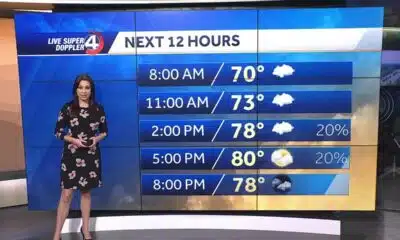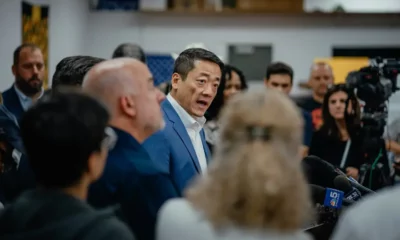News from the South - Georgia News Feed
Cursive writing in schools? Georgia schools are about to loop it back into the classroom
by Ross Williams, Georgia Recorder
June 23, 2025
The next generation of Georgia youths may be able to decipher those birthday cards from grandma without any help from a grown-up.
That’s because Georgia’s new English language arts standards, which take effect in July, will include an emphasis on handwriting, and particularly cursive. The standards will address handwriting starting in kindergarten and move to cursive in third through fifth grade. The previous standards did not have an explicit place for handwriting.
“We want to ensure that our students, when they graduate from the state of Georgia, have all the skills they need,” said April Aldridge, deputy superintendent of teaching and learning at the Georgia Department of Education. “In the world we live in, that means we have to have a varied degree of skills and we need to know when to use the skills in which situations.”
“The skill of handwriting, I wouldn’t say that it’s an antiquated skill because I think most of us use handwriting at some point in our lives every single day, whether it’s in formal or informal situations, so I think it’s just one of the tools that students need to be proficient in,” she added.
While some parents may embrace it, others parents question whether incorporating cursive lessons into English class is the best use of instruction time.
Some said students would be better served by using their instructional time to learn to type or become more savvy with technology.
Brittany Klein, a parent of children in the Cherokee County School System, said she taught her daughter cursive during the COVID-19 pandemic and her son learned it in school, but don’t ask either of them to write in cursive today.
“I am not opposed to cursive,” she said. “I just think if they aren’t going to use it regularly it’s a wasted skill. My kids aren’t even in high school yet and they completely forgot.”
But Sarah Welch, an English language arts program specialist with the Georgia Department of Education, said there’s a greater benefit to mastering handwriting than signing on the dotted line or interpreting grandma’s birthday wishes.
When kids are fluent writers, they can dedicate more brain power to expressing their thoughts instead of moving their pencils.
“If they’re putting so much emphasis on forming the letters and writing the words, that’s taking away their ability to really focus on organizing and expressing their ideas clearly,” Welch said. “And so the research actually shows that cursive handwriting – which is faster than print – really, it enhances their writing fluency. It also supports spelling, but aside from that it really frees up their cognitive resources to let them dig into those higher level reading and higher level writing tasks and being able to organize and express their thoughts because that’s where their minds can go.”
Reinhardt University education professor Debby Pinion, who teaches teachers about reading and dyslexia, said she thinks the new standards will be good for all students but could be especially helpful for children with dyslexia.
That’s because unlike writing block letters, which involves a lot of picking up and putting back down your pencil, when you write in cursive, each word is its own discrete unit.
“With cursive handwriting, it’s a continuous motion until the end of the word,” she said. “So students who are having trouble with position and writing then have an easier time because it just flows per word instead of a manuscript, which is just one letter at a time. So they don’t have to stop and think, ‘which way do I go? Where are the lines? What do I do?’”
“The key word is fluency,” she added. “Just like when we read fluently, that’s not really how fast, but really how smoothly we read. And the same thing is for writing. It helps with fluency so that you’re not starting and stopping, which then impedes your thought process when the object of the game is to write something. So if how we’re writing decreases the flow of our brain fluency, then that’s a problem for students with dyslexia. But cursive handwriting, like any strategy that is used for a child with dyslexia, helps all children. It raises all the ships in the sea.”
YOU MAKE OUR WORK POSSIBLE.
Georgia Recorder is part of States Newsroom, a nonprofit news network supported by grants and a coalition of donors as a 501c(3) public charity. Georgia Recorder maintains editorial independence. Contact Editor Jill Nolin for questions: info@georgiarecorder.com.
The post Cursive writing in schools? Georgia schools are about to loop it back into the classroom appeared first on georgiarecorder.com
Note: The following A.I. based commentary is not part of the original article, reproduced above, but is offered in the hopes that it will promote greater media literacy and critical thinking, by making any potential bias more visible to the reader –Staff Editor.
Political Bias Rating: Centrist
This article presents a balanced and factual report on Georgia’s new English language arts standards, specifically the inclusion of cursive handwriting in the curriculum. It provides perspectives from education officials supporting the change, parents who question its practical value, and experts discussing the cognitive and developmental benefits. The language is neutral and informative, without favoring a particular political ideology or framing the issue in partisan terms. The coverage focuses on educational policy and its implications for students, reflecting a straightforward, centrist approach.
News from the South - Georgia News Feed
Labubu vs. Lafufu: How to spot a fake doll | FOX 5 News
SUMMARY: Counterfeit Loo Dolls, a popular and trendy item, are increasingly targeted by scammers, according to the Better Business Bureau (BBB). Many consumers have reported receiving fake dolls or never receiving their orders when purchasing from fraudulent websites. To avoid scams, the BBB advises researching sellers thoroughly by reading reviews and checking ratings on bbb.org. Use secure payment methods like credit cards instead of apps like Cash App or Venmo. Shoppers should avoid clicking on the first search result and be cautious of deals that seem too good to be true. Victims can report scams at bbb.org/scamtracker to protect others.
The Better Business Bureau is sounding the alarm after a number of Labubu Doll buyers reportedly bought counterfeit toys. Here’s how to spot and report a Labubu scam to the BBB.
Subscribe to FOX 5 Atlanta!: https://bit.ly/3vpFpcm
Watch FOX 5 Atlanta Live: https://www.fox5atlanta.com/live
FOX 5 Atlanta delivers breaking news, live events, investigations, politics, entertainment, business news and local stories from metro Atlanta, north Georgia and across the nation.
Watch more from FOX 5 Atlanta on YouTube:
FOX 5 News: https://www.youtube.com/playlist?list=PLUgtVJuOxfqkmrF1fONNmi8nKI0Z-FPE-
FOX 5 Atlanta I-Team: https://www.youtube.com/playlist?list=PLUgtVJuOxfqlb_I16wBwizoAoUsfKEeWB
Good Day Atlanta: https://www.youtube.com/playlist?list=PLUgtVJuOxfqlKT5xsbsPFgr5EBzdsWTvG
FOX 5 Extras: https://www.youtube.com/playlist?list=PLUgtVJuOxfqli-5MS_2X-i6bNGWvV0RYP
You Decide: https://www.youtube.com/playlist?list=PLUgtVJuOxfqnCKb7UkRde2NXuaoPEAXut
Download the FOX 5 Atlanta app: https://www.fox5atlanta.com/app
Download the FOX 5 Storm Team app: https://www.fox5atlanta.com/storm
Follow FOX 5 Atlanta on Facebook: https://facebook.com/fox5atlanta
Follow FOX 5 Atlanta on Twitter: https://twitter.com/FOX5Atlanta
Follow FOX 5 Atlanta on Instagram: https://www.instagram.com/fox5atlanta/
Subscribe to the Morning Brief and other newsletters from FOX 5 Atlanta: https://www.fox5atlanta.com/email
News from the South - Georgia News Feed
Dancing with the Stars prom gives folks an opportunity to connect in Evans
SUMMARY: Columbia County Parks, Recreation, and Events hosted its first “Dancing With the Stars” prom in Evans, Georgia, aimed at older teens and adults with special needs. Over 50 attendees and their caregivers enjoyed an evening of dancing, food, and music. Janet Wheatley, Programs and Events Manager, highlighted the event’s goal to create inclusive social opportunities and help participants connect with peers and resources. Caregivers emphasized the importance of such events for socialization and support. Attendees expressed excitement and joy. The event seeks to grow annually, fostering community and inclusion. More information is available on the Columbia County Parks website.
The post Dancing with the Stars prom gives folks an opportunity to connect in Evans appeared first on www.wjbf.com
News from the South - Georgia News Feed
Patrick Joseph White: Who is the accused Emory and CDC shooter?
SUMMARY: Patrick Joseph White, 30, from Kennesaw, is identified as the shooter in a deadly incident near the CDC campus in DeKalb County, close to Emory University. The shooting occurred just before 5 p.m. Friday, damaging at least four CDC buildings with multiple bullet holes. White was found dead on the second floor of a nearby CVS, struck by gunfire; it is unclear if it was self-inflicted or by police. Neighbors said White lived with his parents and believed the COVID-19 vaccine caused illness. Officer David Rose, a new Dekalb County police recruit, was killed responding to the scene. The motive remains unknown.
The Georgia Bureau of Investigation has identified Patrick Joseph White as the active shooter in an incident near Emory University and the Centers for Disease Control and Prevention that left a DeKalb police officer dead. The GBI has not confirmed a motive for the shooting. However, one of White’s neighbors said that he was upset over the COVID-19 vaccine. Another neighbor said they would not have suspected White of doing something like this.
Subscribe to FOX 5 Atlanta!: https://bit.ly/3vpFpcm
Watch FOX 5 Atlanta Live: https://www.fox5atlanta.com/live
FOX 5 Atlanta delivers breaking news, live events, investigations, politics, entertainment, business news and local stories from metro Atlanta, north Georgia and across the nation.
Watch more from FOX 5 Atlanta on YouTube:
FOX 5 News: https://www.youtube.com/playlist?list=PLUgtVJuOxfqkmrF1fONNmi8nKI0Z-FPE-
FOX 5 Atlanta I-Team: https://www.youtube.com/playlist?list=PLUgtVJuOxfqlb_I16wBwizoAoUsfKEeWB
Good Day Atlanta: https://www.youtube.com/playlist?list=PLUgtVJuOxfqlKT5xsbsPFgr5EBzdsWTvG
FOX 5 Extras: https://www.youtube.com/playlist?list=PLUgtVJuOxfqli-5MS_2X-i6bNGWvV0RYP
You Decide: https://www.youtube.com/playlist?list=PLUgtVJuOxfqnCKb7UkRde2NXuaoPEAXut
Download the FOX 5 Atlanta app: https://www.fox5atlanta.com/app
Download the FOX 5 Storm Team app: https://www.fox5atlanta.com/storm
Follow FOX 5 Atlanta on Facebook: https://facebook.com/fox5atlanta
Follow FOX 5 Atlanta on Twitter: https://twitter.com/FOX5Atlanta
Follow FOX 5 Atlanta on Instagram: https://www.instagram.com/fox5atlanta/
Subscribe to the Morning Brief and other newsletters from FOX 5 Atlanta: https://www.fox5atlanta.com/email
-
Mississippi Today6 days ago
After 30 years in prison, Mississippi woman dies from cancer she says was preventable
-
News from the South - Texas News Feed6 days ago
Texas redistricting: What to know about Dems’ quorum break
-
News from the South - North Carolina News Feed4 days ago
Two people unaccounted for in Spring Lake after flash flooding
-
Mississippi Today6 days ago
Brain drain: Mother understands her daughters’ decisions to leave Mississippi
-
News from the South - Texas News Feed7 days ago
Pritzker says Texas Democrats who fled state will be protected amid arrest threats
-
News from the South - Georgia News Feed6 days ago
29-year-old killed after driving off road in 'dangerous' section road | FOX 5 News
-
News from the South - Louisiana News Feed7 days ago
Plans for Northside library up for first vote – The Current
-
Local News Video7 days ago
Sparklight offers free backpacks and school supplies to Coast kids











































